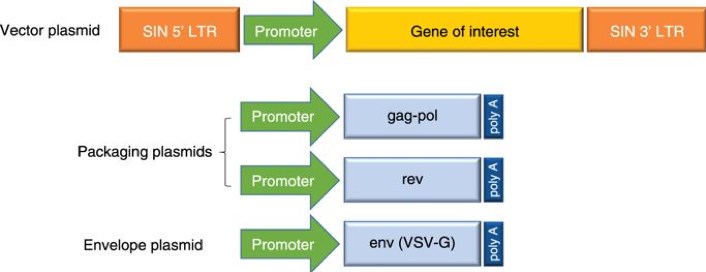Advanced Lentiviral Vector Development for Gene Therapy
The purpose of gene therapy is to transmit a particular disease-associated gene to a target cell and directly express the gene to achieve a therapeutic effect. It has broad application prospects in the treatment of hereditary, metabolic, neurological diseases, cancer and AIDS. The key to the success of gene therapy is to choose the appropriate vector system. As an exogenous gene expression vector, lentivirus has unique characteristics and advantages, including: (i) infecting both dividing and non-dividing cells; (ii) transferring large-capacity gene fragments; (iii) sustained expression of exogenous genes in the host; (iv) low toxicity; and (v) potentially safer integration site profile, etc., which has made it a hot spot in the research of contemporary gene therapy vectors.
Creative Biolabs has established a dedicated gene therapy team focused on the cutting-edge advances of gene therapy, which has enabled us to provide our clients with advanced lentiviral vector development services for various diseases targeted by gene therapy.
Overview of Our Advanced Lentiviral Vector System
The first generation of lentiviral vectors were designed to contain a large number of HIV genomes, including the gag and pol genes, as well as the most common envelope protein VSV-G. VSV-G recognizes a ubiquitously expressed receptor that enables lentiviral vectors to transduce a variety of cells. Subsequently, a safer second-generation lentiviral vector was developed to remove the helper virulence factor genes: vif, vpr, vpu and nef. The removal of the helper gene did not affect the virus's ability to infect, but increased the safety of the vector.
We provide the advanced third-generation lentiviral vectors to further enhance safety by making the viral gene components into separate plasmids, making the production of recombinant viruses even more impossible. In the third-generation system, the tat gene is removed and the 3' LTR deletion mutation introduced into the viral genome is produced to generate a self-inactivating (SIN) lentiviral vector, further improving safety.
 Figure 1. Third-generation lentiviral vector. (Milone, 2018)
Figure 1. Third-generation lentiviral vector. (Milone, 2018)
Clinical Use of Our Advanced Lentiviral Vector
The third generation of self-inactivating lentiviral vectors have recently been used in several clinical trials. CAR T cell therapy engineered with lentiviral vectors has demonstrated remarkable clinical success in patients with B cell malignancies. Lentiviral vector-based gene transfer to HSCs is used to treat several hereditary diseases, including beta-thalassemia, X-linked adrenoleukodystrophy, and metachromatic leukodystrophy. No carrier-related adverse events were reported in these trials.
Currently, Creative Biolabs offers comprehensive lentiviral vectors with multiple cutting-edge modifications used for the following diseases (including but not limited to) based gene therapy:
Following the development of the lentiviral vector you are interested in, Creative Biolabs also conducts a series of analytical assays, such as safety determination, titration service and in vitro / in vivo activity evaluation to ensure the effects of transgenic lentivirus. Based on structural optimization, we also offer advanced lentiviral vector development service for basic research to meet your needs.
Please feel free to contact us and our experienced technicians will give you the most detailed answers to your questions.
Reference
- Milone, M.C.; et al. (2018). Una O'Doherty. Clinical use of lentiviral vectors. Leukemia. 32(7):1529-1541. Distributed under Open Access license CC BY 4.0, without modification.
